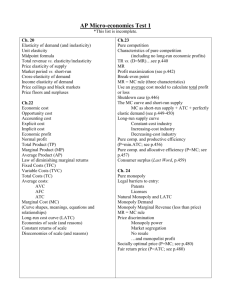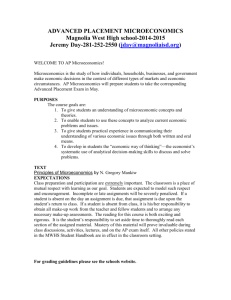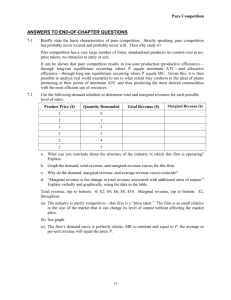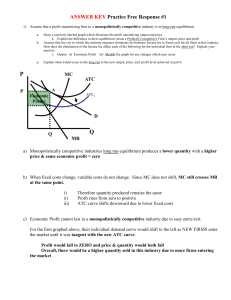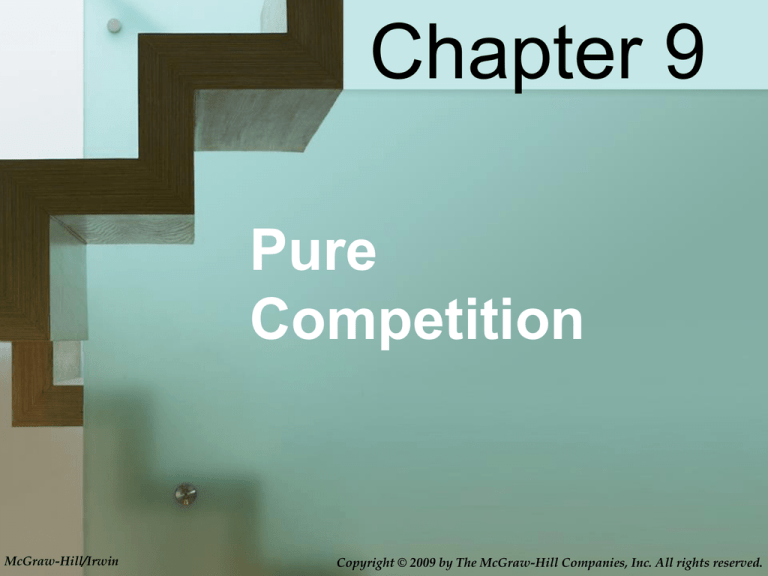
Chapter 9
Pure
Competition
McGraw-Hill/Irwin
Copyright © 2009 by The McGraw-Hill Companies, Inc. All rights reserved.
Chapter Objectives
• The four basic market models
• Conditions for pure competition
• Profit maximization for
competitive firms
• The competitive firm supply
curve
• Industry entry and exit
• Industry cost structure
• Economic efficiency
9-2
Four Market Models
•
•
•
•
Pure competition
Pure monopoly
Monopolistic competition
Oligopoly
Imperfect Competition
Pure
Competition
Monopolistic
Competition
Oligopoly
Pure
Monopoly
Market Structure Continuum
9-3
Pure Competition
•
•
•
•
•
Very large numbers
Standardized product
“Price takers”
Free entry and exit
Perfectly elastic demand
–Average revenue
–Marginal revenue
–Price
9-5
Pure Competition
$1179
P
Firm’s
Revenue
Data
917
QD TR
$131 0
131 1
131 2
131 3
131 4
131 5
131 6
131 7
131 8
131 9
131 10
TR
1048
$0
131
262
393
524
655
786
917
1048
1179
1310
MR
] $131
] 131
] 131
] 131
] 131
] 131
] 131
] 131
] 131
] 131
Price and Revenue
Firm’s
Demand
Schedule
(Average
Revenue)
786
655
524
393
262
D = MR = AR
131
2
4
6
8
10
Quantity Demanded (Sold)
12
9-6
Short Run Profit Maximization
• Market price is given
• Three questions:
–Should the product be produced?
–If so, in what amount?
–What economic profit (loss) will
be realized?
9-7
Profit Maximization
• Two approaches
• Total revenue and total cost
approach
–Produce where TR-TC is greatest
• Marginal revenue and marginal
cost approach
–Produce where MR=MC
9-8
Total Revenue Total Cost Approach
Price = $131
(1)
Total Product
(Output) (Q)
0
1
2
3
4
5
6
7
8
9
10
(2)
Total Fixed
Cost (TFC)
(3)
Total Variable
Cost (TVC)
$100
100
100
100
100
100
100
100
100
100
100
$0
90
170
240
300
370
450
540
650
780
930
(4)
(5)
(6)
Total Cost Total Revenue Profit (+)
(TC)
(TR)
or Loss (-)
$100
190
270
340
400
470
550
640
750
880
1030
$0
131
262
393
524
655
786
917
1048
1179
1310
$-100
-59
-8
+53
+124
+185
+236
+277
+298
+299
+280
Do
You
SeeGraph
Profit Maximization?
Now
Let’s
The Results…
9-9
Total Revenue Total Cost Approach
Total Economic
Profit
Total Revenue and Total Cost
$1800
1700
1600
1500
1400
1300
1200
1100
1000
900
800
700
600
500
400
300
200
100
Break-Even Point
(Normal Profit)
Total Revenue, (TR)
Maximum
Economic
Profit
$299
Total Cost,
(TC)
P=$131
Break-Even Point
(Normal Profit)
0 1 2 3 4 5 6 7 8 9 10 11 12 13 14
Quantity Demanded (Sold)
$500
400
300
200
100
Total Economic
Profit
$299
0 1 2 3 4 5 6 7 8 9 10 11 12 13 14
Quantity Demanded (Sold)
9-10
Marginal Revenue Marginal Cost
Approach
(1)
Total
Product
(Output)
0
1
2
3
4
5
6
7
8
9
10
(2)
Average
Fixed
Cost
(AFC)
$100.00
50.00
33.33
25.00
20.00
16.67
14.29
12.50
11.11
10.00
(3)
Average
Variable
Cost
(AVC)
(4)
Average
Total
Cost
(ATC)
$90.00 $190.00
85.00 135.00
80.00 113.33
75.00 100.00
74.00
94.00
75.00
91.67
77.14
91.43
81.25
93.75
86.67
97.78
93.00 103.00
(5)
Marginal
Cost
(MC)
$90
80
70
60
70
80
90
110
130
150
(6)
Marginal
Revenue
(MR)
(7)
Profit (+)
or Loss (-)
$131
131
131
131
131
131
131
131
131
131
$-100
-59
-8
+53
+124
+185
+236
+277
+298
+299
+280
Surprise
- Now
Let’s GraphNow?
It…
DoNo
You
See Profit
Maximization
9-11
Marginal Revenue Marginal Cost
Approach
Cost and Revenue
$200
MR = MC
150
MC
P=$131
MR = P
ATC
Economic Profit
100
AVC
A=$97.78
50
0
1
2
3
4
5
6
7
8
9
10
Output
9-12
Short Run Profit Maximization
• Produce where MR (=P) = MC
• Suffer loss, still produce?
• Yes if loss is less than fixed cost
–Cover variable cost
• Shut down if loss greater than
fixed cost
• Produce if P > min AVC
9-13
Short Run Loss Minimizing Case
Cost and Revenue
$200
Lower the Price to $81 and
Observe the Results!
150
MC
Loss
A=$91.67
ATC
AVC
100
P=$81
50
0
MR = P
V = $75
1
2
3
4
5
6
7
8
9
10
Output
9-14
Short Run Shut Down Case
Cost and Revenue
$200
Lower the Price Further to
$71 and Observe the Results!
MC
150
ATC
V = $74
100
AVC
MR = P
P=$71
Short-Run
Shut Down Point
P < Minimum AVC
$71 < $74
50
0
1
2
3
4
5
6
7
8
9
10
Output
9-15
Short-Run Supply Curve
Continuing the Same Example…
Supply Schedule of a Competitive Firm
Quantity
Maximum Profit (+)
Price
Supplied
or Minimum Loss (-)
$151
10
$+480
131
9
+299
111
8
+138
91
7
-3
81
6
-64
71
0
-100
61
0
-100
The schedule shows the quantity a firm
will produce at a variety of prices
9-16
Short-Run Supply Curve
Cost and Revenues (Dollars)
Firms produce where MR=MC
e
P5
P3
P2
P1
MR5
d
P4
MC
ATC
c
AVC
b
a
MR4
MR3
MR2
MR1
This Price is Below AVC
And Will Not Be Produced
0
Q2
Q3
Q4
Quantity Supplied
Q5
9-17
Short-Run Supply Curve
Firms produce where MR=MC
Cost and Revenues (Dollars)
Examine the MC for the Competitive Firm
MC Above AVC Becomes
the Short-Run Supply Curve
Break-even
(Normal Profit) Point
e
P5
P3
P2
P1
MC
MR5
d
P4
S
ATC
c
AVC
b
a
MR4
MR3
MR2
MR1
Shut-Down Point
(If P is Below)
0
Q2
Q3
Q4
Quantity Supplied
Q5
9-18
Firm and Industry Supply
• Changes in firm supply
–Shifts in marginal cost
–Input price or technology
• The industry (total) supply curve
–Sum of individual supply
• Industry supply and demand
–Determine market price
9-19
Firm and Industry Supply
Single Firm
Industry
p
P
S = ∑ MC’s
s = MC
Economic
Profit
ATC
d
$111
$111
AVC
D
0
8
p
0
8000
P
Competitive firm must take the price that is
Established by industry supply and demand
9-20
Long Run Profit Maximization
• Assumptions
–Entry and exit only
–Identical costs
–Constant-cost industry
• Goal of the analysis
–In the long run, P = min ATC
–Entry eliminates profits
–Exit eliminates losses
9-21
Entry Eliminates Profits
Single Firm
Industry
p
P
S1
MC
ATC
$60
$60
50
50
S2
MR
D2
40
40
D1
0
100
p
0
80,000
90,000
100,000
P
An increase in demand temporarily raises price
Higher prices draw in new competitors
Increased supply returns price to equilibrium
9-22
Exit Eliminates Losses
Single Firm
Industry
p
P
S3
MC
ATC
$60
$60
50
50
S1
MR
D1
40
40
D3
0
100
p
0
80,000
90,000
100,000 P
A decrease in demand temporarily lowers price
Lower prices drive away some competitors
Decreased supply returns price to equilibrium
9-23
Long Run Supply
• Constant cost industry
– Entry/exit does not affect LR ATC
– Constant resource price
– Special case – industry demand for
resources small portion of total
• Increasing cost industry
–Most industries
–LR ATC increases with expansion
–Specialized resources
• Decreasing cost industry
9-24
Long-Run Supply Curve
Constant-Cost Industry
P
P1
P2
$50
Z3
Z1
Z2
S
P3
D3
0
Q3
90,000
D1
Q1
100,000
D2
Q2
110,000
Q
9-25
Long-Run Supply Curve
Increasing-Cost Industry
P
S
P2
$55
P1
$50
Y2
Y1
P3
$40
Y3
D2
D1
D3
0
Q3
90,000
Q1
100,000
Q2
110,000
Q
How would a decreasing-cost industry look?
9-26
Pure Competition and Efficiency
• Productive efficiency
P = minimum ATC
• Allocative efficiency
P = MC
• Maximum consumer and
producer surplus
• Dynamic adjustments
• “Invisible Hand” revisited
9-27
Long-Run Equilibrium
Single Firm
P=MC=Minimum
ATC (Normal Profit)
Market
MC
S
Price
Price
ATC
MR
P
P
D
0
Qf
Quantity
0
Qe
Quantity
Productive Efficiency: Price = minimum ATC
Allocative Efficiency: Price = MC
Pure competition has both in
its long-run equilibrium
9-28
The Case of Generic Drugs
• Efficiency gains from entry
–Lower price and greater output
• Purpose of drug patent
–Encourage R&D
–Cost recovery
• Expiration of patent on drugs
–Generics enter
–Profits decrease, output increase
–Combined CS and PS increase
9-29
The Case of Generic Drugs
New Producers Enter Market
Initial Patent Price
P1
Price
• As price
decreases to f,
• Consumer
surplus abc
increases to adf
• Producer and
consumer
surplus is
maximized
as shown by
the gray triangle
a
P2
b
S
c
d
f
D
Q1
Q2
Quantity
Result: Greater Quantity at Lower Prices
as Predicted by the Competitive Model
9-30
Key Terms
• pure competition
• pure monopoly
• monopolistic
competition
• oligopoly
• imperfect
competition
• price taker
• average revenue
• total revenue
• marginal revenue
• break-even point
• MR=MC rule
• short-run supply
curve
• long-run supply
curve
• constant-cost
industry
• increasing-cost
industry
• decreasing-cost
industry
• productive
efficiency
• allocative efficiency
• consumer surplus
• producer surplus
9-31
Next Chapter Preview…
Pure
Monopoly
9-32



